Population of Siquijor Province reaches 103,395
The population of Siquijor hits 103,395 in 2020 from 81,598 populations in 2000. The 2020 population grew by 7,411 from the 95,984 population in 2015 and by 12,329 compared with the population of 91,066 in year 2010. Around 10 thousand persons were added to the province population every decade since 2000.
The growth of the population in Siquijor is relatively higher with a Population Growth Rate or PGR of 1.58 percent for the period 2015 to 2020. By comparison, the rate at which the province’s population grew during the period 2010 to 2015 was lower at 1.01 percent. During years 2000 to 2010 the PGR was 1.10 percent. See Figure 1
for Siquijor population and growth rate by census year. Siquijor population density is 306 as of 01 May 2020
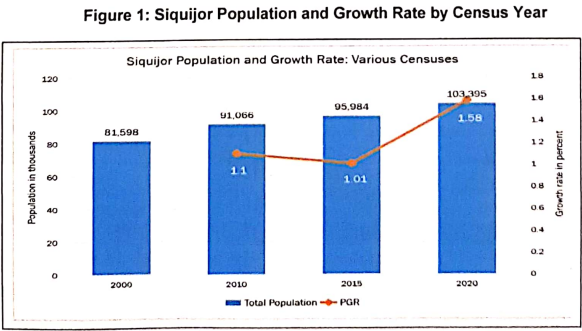
With a total land area of approximately 337.49 square kilometers, the population density of Siquijor in 2020 was posted at 306 persons per square kilometer. This means that in every square kilometer area there are 306 persons residing.
The 2020 population density of 306 persons has an increase of 22 persons per square kilometer from the population density of 284 persons per square kilometer in 2015. In 2010, there were 270 persons residing in every square kilometer of land as compared to 242 persons per square kilometer in 2000. See Figure 2
for the population density by census year.
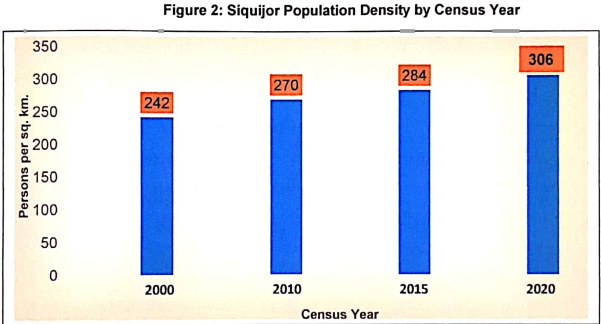
Municipality of San Juan is densely populated among six municipalities
Among the six (6) municipalities in Siquijor, San Juan was the most densely populated with 369 persons per square kilometer as of 01 May 2020. This is followed by the municipalities of Siquijor (Capital), Lazi, Larena, Maria and Enrique Villanueva with a density of 319, 318, 290, 270 and 237 respectively. See Table 1 for the Population density per municipality.
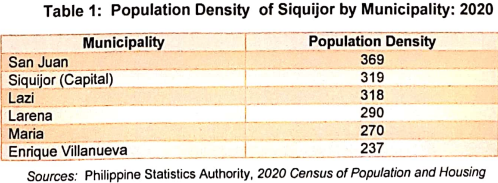
Sources: Philippine Statistics Authority, 2020 Census of Population and Housing
Municipality of Siquijor has the biggest land area among the six municipalities.
Municipality of Siquijor (Capital) has the biggest Land area with 90.70 square kilometer or 27 percent of the Province total land area among the six municipalities of Siquijor Province. This is followed by the municipalities of Lazi with a land area of 70.64 sq. km. and 21 percent of the total land area of the province. Third in rank is Maria with a land area of 53.37 sq. km. and 16 percent of the total land area of the province.
Municipality of Larena ranked fourth with a land area of 49.61 sq.km. and 15 percent of the total land area of the province then followed by San Juan with a land area of 44.37 sq.km. and 13 percent of the total land area of the province. Enrique Villanueva has the smallest land area of 28.60 sq.km. and 8 percent of the total land area of the province.
Meanwhile, the land areas were based on the 2013 Masterlist of Land Areas of Cities and Municipalities provided to the Philippine Statistics Authority (PSA) by the Land Management Bureau (LMB).
Figure 3 shows the land area sharing of Siquijor by municipality. See also Table 2 for the quantitative data of land area by municipality.
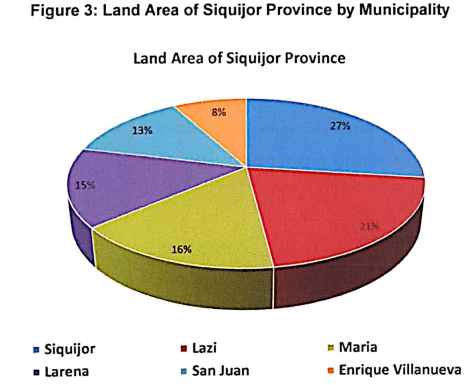
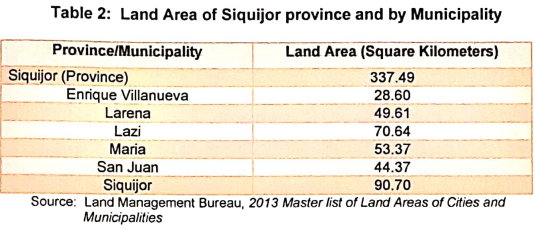
Technical Notes
The 2020 Census of Population and Housing (CPH)) was undertaken by the Philippine Statistics Authority (PSA) in September 2020 as mandated by Republic Act No. 10625, otherwise known as the Philippine Statistics Act of 2013. It was the 15th census of population and 7th census of Housing that was undertaken since the first census in 1903. The 2020 CPH was designed primarily to take an inventory of the total population and housing units all over the Philippines and collect information about the demographic, social, economic, and cultural characteristics and facilities of the housing units. The reference period for the 2020 CPH was 01 May 2020 (12:01 a.m.). The enumeration period was delayed and conducted in September 2020 due to the pandemic caused by the COVID-19.
Definition of Terms
Census of Population and Housing refers to the complete process of collecting, compiling, evaluating, analyzing, publishing, and disseminating data about the population and housing units in the country.
Population Density is a measurement of population per square area usually in square kilometer.
Total Population is composed of the household population plus the institutional population.
Land area is the area in square kilometers of the land-based portions of standard geographic areas. Land area data are provided for the sole purpose of calculating population density.

